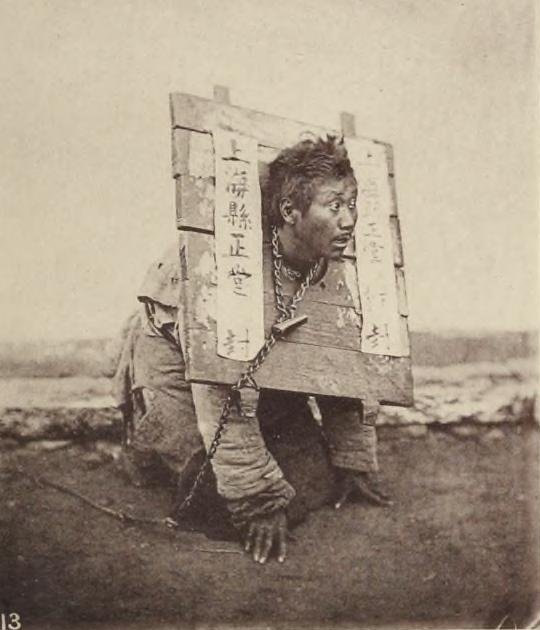Thieves, assassins and other criminals were punished at any time by any expiation, fatal or not, but time passes and the punishments do not resemble each other. Some have even been relegated to oblivion, being robbed by the famous guillotine, the electric lightning chair or the horrible torture of bamboo, here are 9 very strange punishments, some of which would have been hidden by justice, or little revealed in the open.
1 / The cangue
The Chinese punishment par excellence in the 17th century, with a square wooden panel around his neck, the prisoner, who had the misfortune to taste it, was forced to ask for help from passers-by for food, being unable to reach his mouth with his hands, a certain variant of the pillory ...
2 / Risso's dolphin
In the days of Napoleon, on the ships, the punishment reserved for sailors who committed a minor offense was called the Risso's dolphin, the principle ? Tie the hands of the unfortunate brash over his head and then pour several buckets of frozen water inside the sleeves of his clothes. The name of this icy punishment could be explained by the noise made by the poor moussaillon who was overwhelmed, similar to that of a dolphin of Risso, a special dolphin, whose name commemorates the naturalist Antoine Risso.
3 / The drunk bell
All the punishments were not made to kill, fortunately. Some had the power to embarrass their victims to the utmost, a way to dissuade them from starting again ... The bell to drunkard was part of it, this method, used during the 16th and 17th centuries, consisted of putting a large wooden barrel containing a hole to slide the head and two others for the arms to the alcoholic in question. Thus harnessed, the incorrigible drunk, having trouble evolving, zigzagging without having drunk a drop, would have been better sensitized to the dangers of alcohol, besides enjoying a beautiful humiliation ...
4 / The Welsh Not
In the 19th century, Welsh Not a corrective system to discourage children from speaking Welsh, was introduced in schools in Wales and England, and they were taught English at their youngest age, if a child broke the law and deliberately spoke his mother tongue, a small block of wood with the initials W.N, if the young holder of this poisoned necklace could hear another child speak his tongue, he could then delegate the piece of wood to him, at the end of the day, the child who had the dreaded totem around his neck was beaten ...
5 / The treadmill
Even though the treadmill was an instrument of physical torture in 1817, it is nevertheless an ancestor of the treadmill we sweat in today's favorite gym, introduced in most English prisons, this method of exhausting punishment consisted of running or walking a prisoner for days, or hours for the lucky ones, using a mechanism using a hydraulic wheel , Like the wheels for horses ...
6 / Judicium Dei
The last judgment has often arrived in courtrooms, if one dares to call them that way. The Judgment of God, or Judicium Dei, is a punishment that would have sealed the fate of several accused, whether in support or not. In a trial between two parties, it was often impossible at that time to decide between a victim and an accused. Thus the court went to God, considering him the best judge. Duels, burns, or even mere randomness, the accused were allotted punishments more sordid than the others, which would have been allowed to prove their innocence. If an accused did not get away with it, it was because the victim deserved his death. Otherwise, God had pardoned them, and had rendered their verdict in their place ...
7 / The scalping
Scalping, or more precisely pitchcapping, would have been a form of torture used by military forces during the Irish Revolution of 1798, to mark the rebels. The pitchcap (literally tar cap) was a kind of conical hat created from scratch from a garment or fabric at hand. The executioner filled this piece of cloth with a kind of boiling tar, administering to his victim the fatal mixture by pressing it on his skull soon scalped ...
8 / The picket
Used to punish criminals at the end of the medieval era in Europe, the punishment of the picket consisted in planting a sharp wooden pole in the ground, and suspending the villain with a rope attached to his Wrist, so that it can only fit one foot on the sharpened post, for hours, the victim had to hold, either by choosing to privilege his wrists or his feet ...
9 / Sanction No. 1
When the English flogging was abolished in 1881, the military authorities had to find a new way of punishing offenders guilty of minor offenses (alcoholism, for example). The sanction No. 1 would have come into existence, in force until 1920, all the same. Attached several hours a day, the victim was regularly monitored by an officer who checked her posture. Rather regarded as a simple humiliation, this numbered sanction would still have put in danger the lives of several humiliated, some would have been attached to train wagons, in full shooting of enemy shells ...



Very interesting, great post!